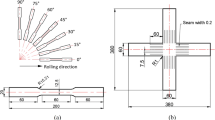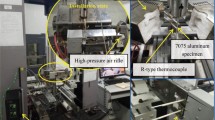Abstract
A new temperature-dependent anisotropic hardening and yield function based on non-associated flow rule (NAFR) which accurately describes the anisotropic properties of aluminium alloy sheet metal is presented in this paper. This new NAFR coupling yield function has been successfully implemented in commercial FEM software Abaqus via user material subroutine UMAT to model warm forming of AA5086-H111 aluminium alloy and good agreement was found in the predicted earing profiles and spring-back compared with experiments. The new NAFR coupling yield function has been shown be superior to the existing Hill48 (associated flow rule) yield function making it suitable for FEA of warm deep drawing and design of tooling for various automotive panels and components.
Similar content being viewed by others
Explore related subjects
Discover the latest articles and news from researchers in related subjects, suggested using machine learning.References
Bolt PJ, Lamboo NAPM, Rozier PJCM (2001) Feasibility of warm drawing of aluminium products. J Mater Process Technol 115(1):118–121
Toros S, Ozturk F, Kacar I (2008) Review of warm forming of aluminum–magnesium alloys. J Mater Process Technol 207(1):1–12
Abedrabbo N, Pourboghrat F, Carsley J (2007) Forming of AA5182-O and AA5754-O at elevated temperatures using coupled thermo-mechanical finite element models. Int J Plast 23(5):841–875
Li D, Ghosh AK (2004) Biaxial warm forming behavior of aluminum sheet alloys. J Mater Process Technol 145(3):281–293
Kim HS, Koç M (2008) Numerical investigations on springback characteristics of aluminum sheet metal alloys in warm forming conditions. J Mater Process Technol 204(1):370–383
Laurent H, Coër J, Manach PY, Oliveira MC, Menezes LF (2015) Experimental and numerical studies on the warm deep drawing of an Al–Mg alloy. Int J Mech Sci 93:59–72
Kumar M, Sotirov N, Chimani CM (2014) Investigations on warm forming of AW-7020-T6 alloy sheet. J Mater Process Technol 214(8):1769–1776
Kim HS, Koç M, Ni J, Ghosh A (2006) Finite element modeling and analysis of warm forming of aluminum alloys—validation through comparisons with experiments and determination of a failure criterion. J Manuf Sci Eng 128(3):613–621
Kim HS (2010) A combined FEA and design of experiments approach for the design and analysis of warm forming of aluminum sheet alloys. Int J Adv Manuf Technol 51(1):1–14
Mahabunphachai S, Koç M (2010) Investigations on forming of aluminum 5052 and 6061 sheet alloys at warm temperatures. Mater Des 31(5):2422–2434
Kurukuri S, Van den Boogaard AH, Miroux A, Holmedal B (2009) Warm forming simulation of Al Mg sheet. J Mater Process Technol 209(15):5636–5645
Grèze R, Manach PY, Laurent H, Thuillier S, Menezes LF (2010) Influence of the temperature on residual stresses and springback effect in an aluminium alloy. Int J Mech Sci 52(9):1094–1100
Manach PY, Grèze R, Laurent H, Thuillier S, Menezes LF (2008) Influence of the temperature on residual stresses and springback effect in an aluminium alloy. Adv Mater Process Technol
Abedrabbo N, Pourboghrat F, Carsley J (2006) Forming of aluminum alloys at elevated temperatures–Part 1: Material characterization. Int J Plast 22(2):314–341
Coër J, Bernard C, Laurent H, Andrade-Campos A, Thuillier S (2011) The effect of temperature on anisotropy properties of an aluminium alloy. Exp Mech 51(7):1185–1195
Abedrabbo N, Pourboghrat F, Carsley J (2006) Forming of aluminum alloys at elevated temperatures–Part 2: Numerical modeling and experimental verification. Int J Plast 22(2):342– 373
Barlat F, Lian K (1989) Plastic behaviour and stretchability of sheet metals. Part I: A yield function for orthotropic sheets under plane stress conditions. Int J Plast 5(1):51–66
Barlat F, Brem JC, Yoon JW, Chung K, Dick RE, Lege DJ, Chu E (2003) Plane stress yield function for aluminium alloy sheets—part 1: theory. Int J Plast 19(9):1297–1319
Yoon JW, Barlat F, Dick RE, Chung K, Kang TJ (2004) Plane stress yield function for aluminium alloy sheets—part II: FE formulation and its implementation. Int J Plast 20(3):495–522
Barlat F, Aretz H, Yoon JW, Karabin ME, Brem JC, Dick RE (2005) Linear transformation-based anisotropic yield functions. Int J Plast 21(5):1009–1039
Yoon JW, Barlat F, Dick RE, Karabin ME (2006) Prediction of six or eight ears in a drawn cup based on a new anisotropic yield function. Int J Plast 22(1):174–193
Aretz H, Aegerter J, Engler O (2010) Analysis of earing in deep drawn cups. AIP Conference Proceedings 1252(1):417–424
Aretz H, Barlat F (2013) New convex yield functions for orthotropic metal plasticity. Int J Non Linear Mech 51:97–111
Min J, Carsley JE, Lin J, Wen Y, Kuhlenkötter B (2016) A non-quadratic constitutive model under non-associated flow rule of sheet metals with anisotropic hardening: modeling and experimental validation. Int J Mech Sci 119:343–359
Lee EH, Stoughton TB, Yoon JW (2017) A yield criterion through coupling of quadratic and non-quadratic functions for anisotropic hardening with non-associated flow rule. Int J Plast 99:120–143
Stoughton TB, Yoon JW (2009) Anisotropic hardening and non-associated flow in proportional loading of sheet metals. Int J Plast 25(9):1777–1817
Safaei M, Lee MG, De Waele W (2015) Evaluation of stress integration algorithms for elastic–plastic constitutive models based on associated and non-associated flow rules. Comput Methods Appl Mech Eng 295:414–445
Park T, Chung K (2012) Non-associated flow rule with symmetric stiffness modulus for isotropic-kinematic hardening and its application for earing in circular cup drawing. Int J Solids Struct 49(25):3582–3593
Yuanming L, Yugui Y, Xiaoxiao C, Shuangyang L (2010) Strength criterion and elastoplastic constitutive model of frozen silt in generalized plastic mechanics. Int J Plast 26(10):1461–1484
Khan AS, Yu S, Liu H (2012) Deformation induced anisotropic responses of Ti–6Al–4V alloy Part II: A strain rate and temperature dependent anisotropic yield criterion. Int J Plast 38:14–26
Van den boogaard AH, Bolt P, Werkhoven R (2001) Modeling of Al Mg sheet forming at elevated temperatures. Int J Form Process 4(3-4):361–375
Hill R (1948) A theory of the yielding and plastic flow of anisotropic metals. Proceedings of the Royal Society of London A: Mathematical. Phys Eng Sci 193(1033):281–297
Hosford WF (1972) A generalized isotropic yield criterion. J Appl Mech 39(2):607–609
Manach PY, Coër J, Laurent H, Yoon JW (2016) Benchmark 3-Springback of an Al-Mg alloy in warm forming conditions. J Phys Conf Ser 734(2):022003
Karbasian H, Tekkaya AE (2010) A review on hot stamping. J Mater Process Technol 210(15):2103–2118
Liu W, Chen BK (2018) Sheet metal anisotropy and optimal non-round blank design in high-speed multi-step forming of AA3104-H19 aluminium alloy can body. Int J Adv Manuf Technol 95(9):4265–4277
Author information
Authors and Affiliations
Corresponding author
Ethics declarations
Conflict of interest
The authors declare that they have no conflict of interest.
Additional information
Publisher’s Note
Springer Nature remains neutral with regard to jurisdictional claims in published maps and institutional affiliations.
Appendices
Appendix A
σ1,σ2 and σ3 are the three principal values of the Cauchy stress tensor:
These principal values are the roots of the characteristic equation:
The associated 1st, 2nd and 3rd invariants of σk:
Change the variable using:
The characteristic equation becomes:
The associated invariants of \(\overline {\sigma }_{k}\):
Cardan’s solutions to Eq. 40a:
where z, w are complex number and \(\overline {z}\), \(\overline {w}\) are their conjugate quantities, they are given as:
The principal values of Cauchy stress tensor are computed as:
Appendix B
First-order deviator of the new coupling yield function required in the stress integration algorithm:
where, the first-order deviator of quadric part is given by:
The first-order deviator of non-quadric part is given by:
where, the terms \(\frac {\partial {F_{non-quad}}}{\partial \sigma _{k}}\) are given by:
The terms \(\frac {\partial {\sigma _{k1}}}{\partial {H_{k2}}}\) are given by:
The terms \(\frac {H_{k2}}{\sigma _{ij}}\) are given by:
Rights and permissions
About this article
Cite this article
Liu, W., Chen, B.K. & Pang, Y. A new temperature-dependent anisotropic constitutive model for predicting deformation and spring-back in warm deep drawing of automotive AA5086-H111 aluminium alloy sheet. Int J Adv Manuf Technol 97, 3407–3421 (2018). https://doi.org/10.1007/s00170-018-2161-0
Received:
Accepted:
Published:
Issue Date:
DOI: https://doi.org/10.1007/s00170-018-2161-0




